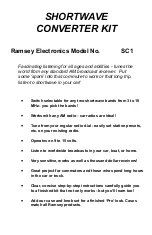
25
12. Direct Switching with push button inputs
SwitchPilot Servo
The SwitchPilot Servo enables the switching of the four servo
outputs without the use of a digital system. Therefore it can be
used on traditional analog layouts. The desired servo setting will
be set via eight push buttons (4 servos with two positions each).
Connect your buttons as shown in figure 17:
• the buttons need to be potential-free
• switching only requires a short impulse
• because of the internal switching only one button can be pressed
at the same time, otherwise the pressing of the buttons will not
be recognized correctly
13. Options for SwitchPilot Extension
The behavior of an optional SwitchPilot Extension module can
be modified with CV 49.
13.1. Time of switching
Normally the relays of the SwitchPilot Extension module switch
immediately after receiving the command. But this can lead to a
short at the frog polarization because the turnout tongue remains
at the previous position for a while. The behavior can be changed
in such a way that the relays only switch in the middle between
positions A and B. The exact switching point of the relays depends
on the desired switching time of the servo.
SwitchPilot Servo
Responsible is CV 49. Set the appropriate bit for each relay output
that needs to be switched delayed. See table in section 17 for
details.
13.2. Assignment of Relays
SwitchPilot
The relays of the SwitchPilot Extension module switch together
with transistor outputs 1 – 4 by factory default. In a few cases
you might want to switch the relays together with servo outputs
5 – 6 (e.g. for frog polarization). Therefore, it is possible with CV
49 to assign the secondary address (servo outputs 5 – 6) to each
relay output.
Direct Switching with push button inputs
Figure 17: Connection of push buttons to SwitchPilot Servo
Servo 1, A
Servo 1, B
Servo 2, A
Servo 2, B
Servo 3, A
Servo 3, B
Servo 4, A
Servo 4, B








































